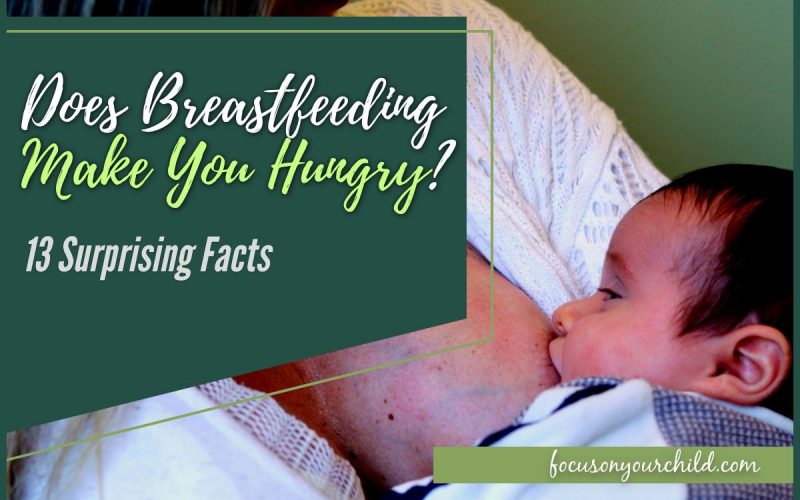No matter how prepared you think you are in the breastfeeding game, something is bound to come up and surprise you. Breastfeeding is natural and one of the most special events in a new parent’s life. It can throw huge curveballs at you though, and it pays to be prepared and knowledgeable on possible scenarios.
While breastfeeding, your body burns up an additional 450 to 500 calories a day (ACOG, 2021). Being constantly hungry while breastfeeding is normal for some. In addition to the calories your body uses to produce milk, your body needs energy to keep up with diaper changes, feedings, and cleaning.
Because everybody is different and responds to breastfeeding differently, some of the things listed below may or may not apply to you. Nonetheless, it pays to be knowledgeable and avoid surprises along your breastfeeding journey.
Surprising Facts About Breastfeeding

-
Breastfeeding Burns Calories Fast
Your body needs energy in the form of calories to keep up with lactation and sustaining an entire other human being. Because of your higher energy expenditure, you may lose the baby weight faster and get back to your pre-pregnancy weight faster than if you were not breastfeeding.
Not only do you spend more energy to produce milk, just having a baby, in general, is exhausting, especially in the first few weeks when your baby needs constant feeds and diaper changes, and may wake up often during the night. It is completely natural for you to feel hungrier and want to eat more at this time.
-
Breastfeeding Makes You Thirsty Faster
Baby’s suckling during breastfeeding is a rather strong thirst stimulus because it is accompanied by decreased osmotic threshold for thirst and release of arginine vasopressin (AVP). The increased blood volume due to increased thirst is beneficial for production and secretion of milk during lactation (Amabebe et al., 2017).
Mothers who breastfeed are encouraged to drink enough water whenever they are thirsty. A common advice would be for them to drink one glass of water with meals and each breastfeeding (Montgomery, 2002). Drinking enough liquids, eating foods with a high moisture content, and avoiding caffeinated food and beverages will keep you healthy and keep you from getting dehydrated.
-
Colostrum is an Amazing Superfood
Colostrum or the milk you first produce, contains antibodies and white blood cells that essentially act as your baby’s first vaccine. The thick colostrum packs in a large amount of calories, proteins, fats, and nutrients in small half-ounce packages, giving your newborn baby adequate nutrition in amounts they can handle.
Colostrum also has laxative effects that help babies pass meconium, or their first poop. Antibodies present in colostrum, specifically the secretory immunoglobulin A (SIgA), coats the baby’s internal organs and lining of the digestive tract preventing infection and inflammation (Duale et al., 2021).
-
Breastmilk Adapts to You and Your Baby’s Health
When you or your baby is ill, your breastmilk adapts to hold more antibodies. The antibodies and immune cells your body produces when you are unwell appear in your breastmilk, allowing you to pass immunity on to your baby.
Your baby’s suckling creates a vacuum effect between your nipple and their mouth. This allows some milk to flow backward into your chest along with some of your baby’s saliva. The white blood cells in your mammary tissue then mount an immune response to the bacteria or viruses in your baby’s saliva which you then pass on to your baby.
-
Breastmilk Isn’t Always White
Most people believe breastmilk to simply be white or cream, but it is more complex than that. The color, consistency, and volume of milk you produce depend on the food you eat, medications you take, and the stage of breastfeeding you are on.
Colostrum, which is the first type of breastmilk you produce, will be a thick, honey-like consistency with a yellow coloration to it. Transitional milk changes from yellow to white as you start producing larger volumes. Mature milk can range from clear and blue-tinged foremilk to hindmilk, which has a higher fat and nutrient content will appear white or yellowish.
Leafy greens can give breastmilk a greenish tinge when eaten in large amounts. Common breastfeeding conditions such as mastitis can cause a pinkish tinge or streaks of blood to appear in breastmilk. In both these cases, it is safe to continue breastfeeding. If you have any concerns over your breastmilk’s color, it is perfectly alright to check with your healthcare provider.
-
Breastfeeding Lowers Cancer Risks
Studies have found that people who breastfeed have much lower risks of reproductive cancer, and that breastfeeding for longer periods results in a lower risk of breast cancer. Other studies have also found associations between breastfeeding and reduced risk of ovarian cancer.
Breastfeeding may also lower your risk of type 2 diabetes, hypertension and even post-partum depression. Although the mechanisms of these benefits are not fully understood yet, they are good enough reason to opt for breastfeeding if you are able to.
-
Breastfeeding Helps You Bond with Your Baby
Breastfeeding promotes skin-to-skin contact between you and your baby, which has proven benefits for both parties involved. Babies who receive skin-to-skin contact cry less and are better able to self-regulate their body temperature.
Skin-to-skin contact also stimulates oxytocin production which promotes feelings of calmness and pleasure in you and your baby, and may decrease your risk of post-partum depression. Oxytocin production also improves milk volume and promotes stronger, more affectionate parent-infant bonding behaviors.
-
Breastfed Babies Are Less Picky Eaters
A study out of the University of Illinois found that babies who were exclusively breastfed for the first 6 months of life were more likely to accept new foods and different food preparations during early childhood as opposed to children who were formula-fed.
The idea is that the food you eat during pregnancy and while nursing affects the taste of your breastmilk. Through breastfeeding, your baby picks up subtle flavors and smells of your food, and may form food preferences similar to your own. If you want your baby to enjoy eating fruits and vegetables from a young age, you need to eat them too.
-
Breastfeeding May Make Babies Smarter
Research reports that 7- and 8-year-old children who were breastfed as babies had IQ test results that averaged 8.3 points higher than those who were not breastfed. While the mechanisms are not certain, it is thought that the higher cholesterol content of breastmilk supports better brain development in infancy and cognition in later life.
-
Breastmilk Helps Babies Sleep Better
Your baby’s circadian rhythm is not fully established until they are about 2 months of age. The amino acid Tryptophan, which is crucial to melatonin or sleep hormone production in humans, can be found in breastmilk.
Because the Tryptophan levels in breastmilk are lowest in the morning and highest in the evening according to a breastfeeding parent’s own circadian rhythm, breastfeeding may help your baby fall asleep faster and stay asleep longer.
-
Breastfeeding Protects Babies From SIDS
According to one study, babies who were breastfed for at least 2 months had a lower risk of sudden infant death syndrome, and that risk is lowered further with longer breastfeeding durations.
One possibility as to why this is, is that breastfed babies have better infant arousal responses and lower arousal thresholds, which are crucial for a baby’s survival. Breastmilk also contains antibodies and immune cells which further protect your baby.
-
Breastfeeding Delays Menstruation
The hormone prolactin produced while breastfeeding inhibits the production of estrogen and progesterone, 2 hormones which are necessary for a menstrual cycle to take place. Some parents who breastfed exclusively report not having cycles for up to a year after their baby’s birth, as opposed to 6-8 weeks without breastfeeding.
Because of this, around-the-clock nursing may provide some form of short-term birth control. The Lactation Amenorrhea Method (LAM) of birth control revolves around the fact that breastfeeding hormones suppress ovulation.
If you do decide to use LAM as a form of birth control, keep in mind that LAM relies on exclusive breastfeeding and the complete absence of menstrual cycles, and that its efficacy rate drops significantly after 6 months.
-
Breastfeeding Saves Time and Money
One of the biggest advantages of breastfeeding is that it is free. Infant formula may cost up between $1,200 and $1,500 a year, not including bottle warmers, bottles, and other accessories. It may also be more convenient and time-saving to simply put a baby to your chest for feedings, as opposed to having to measure, make, and warm a bottle for feeding, especially during sleep-deprived nights.
Final Points

While these are all great reasons to breastfeed your baby, one of the best benefits you could get from breastfeeding is arguably the bond you will share with your baby. Breastfeeding is a unique emotional and physical experience that only you as a breastfeeding parent will share with your baby.
This is not however, meant to discount the experiences of someone unable to breastfeed or decides not to breastfeed. Not breastfeeding does not make you inadequate or any less of a parent than being able to makes you. Breastfeeding or not, what matters the most is that your baby is happy and healthy, and that you are giving your baby the best chances and the best opportunities you can.
